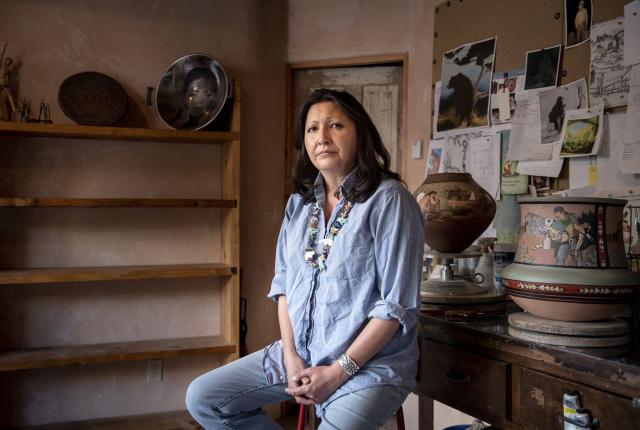Above: Master potter Susan Folwell uses Pop Art imagery, humor, and the reimagining fine art masterpieces in her work. Photograph by Stefan Wachs.
SUSAN FOLWELL IS A POET of contemporary Pueblo pottery. Carrying the generational torch of pottery art passed down from her Santa Clara Pueblo grandmother, Rose Naranjo, and her mother, Jody Folwell, she infuses her clay with personal narrative, social commentary, and experimentation.
“I am a keeper of social history,” says Folwell, who gathers her clay locally, mixes it the traditional way with her feet and hands, and hand-coils her work. After moving to Santa Fe in 2000, she began using a kiln, which helps remove the anxiety associated with a piece surviving the traditional open-flame process. She then paints her pottery with acrylic, wood stain, India ink, and watercolor.
Using Pop Art imagery, humor, and the reimagining of turn-of-the-century masterpieces, Folwell has tackled subjects ranging from school shootings and Osama bin Laden to the pandemic. “I’ve kept moving so much as an artist that now people expect me to keep moving,” she says.
While she’s often regarded as an innovator of Pueblo pottery traditions, Folwell says innovation has always been a part of Native art. Look through the archives at institutions such as the Heard Museum, in Phoenix, she suggests, and compare that pottery to today’s works. “Sometimes you can’t tell which one looks or feels more contemporary,” Folwell says. “There was already individual expression a thousand years ago.”
"I’ve kept moving so much as an artist that now people expect me to keep moving."
Since 2017 she has been creating the Taos Light collection, a series that reinterprets classic paintings by the Taos Society of Artists, a group of 12 Anglo painters who depicted western scenes from 1915 to 1927. In the series, which can be viewed online at Santa Fe’s King Galleries, she imposes imagery from paintings such as Victor Higgins’s Apaches onto her pots and hand-formed iPhones, canned fish, and a loaf of Rainbo bread. The result is an Indigenous interpretation of images that influenced the world’s imagination of Native Americans during the early 1900s. Some pieces in the Taos Light series are meant to be pretty, others humorous, and some carry a deeper message.
Folwell believes the Taos Society and their subjects had a relationship of mutual respect, which puts her at ease in using their imagery with her own. The perspective of Native people has also changed since the TSA paintings were made 100 years ago, she says, allowing for a more objective look back.
In 2017, she created a jar titled Vanishing, inspired by an E.I. Couse painting that portrays a Native American hunter. But where a deer occupies the background of Couse’s painting, Folwell leaves an empty blue. “I chose to leave a blank space because at that time Native Americans had no idea where their future was heading,” she says.
Today, Indigenous artists often bring old conversations and concepts into a modern context. But when Folwell’s mother began introducing social commentary and modern motifs into her work, it wasn’t always well received. Folwell credits her mother for helping to pave the way for contemporary Pueblo potters to blend ancient traditions with postmodern individualism.
“There are enough people doing traditional work that it gives me the freedom to do what I want,” says Folwell. “I’m grateful for that.”
King Galleries
130 Lincoln Ave., Suite D,
Santa Fe; 480-481-0187


